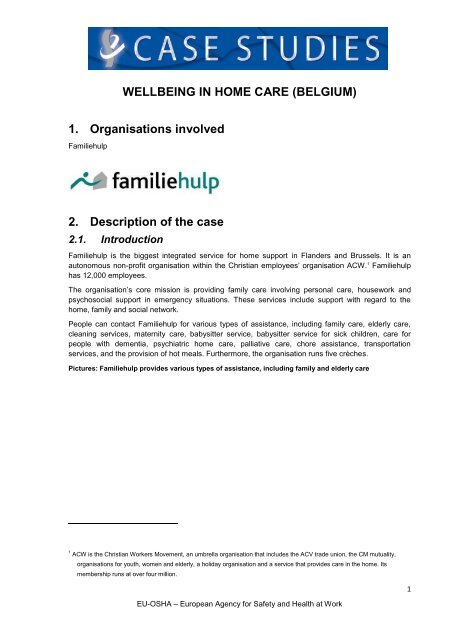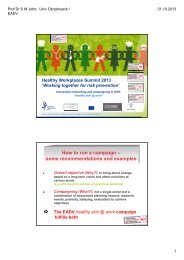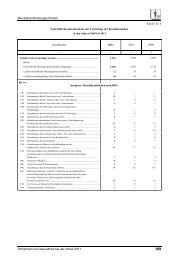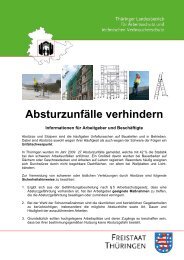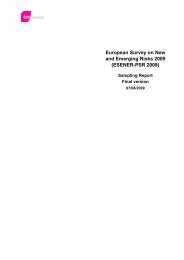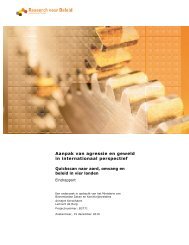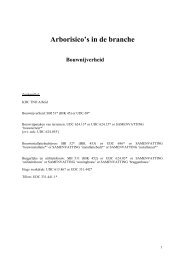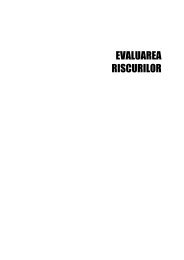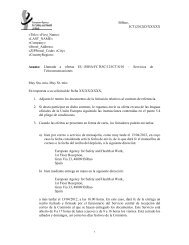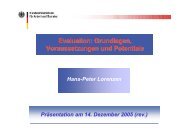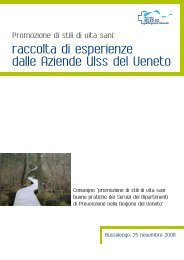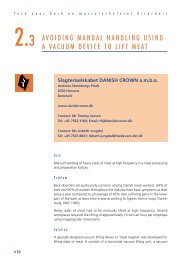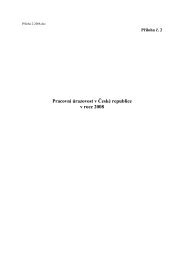Familiehulp - European Agency for Safety and Health at Work
Familiehulp - European Agency for Safety and Health at Work
Familiehulp - European Agency for Safety and Health at Work
Create successful ePaper yourself
Turn your PDF publications into a flip-book with our unique Google optimized e-Paper software.
WELLBEING IN HOME CARE (BELGIUM)<br />
1. Organis<strong>at</strong>ions involved<br />
<strong>Familiehulp</strong><br />
2. Description of the case<br />
2.1. Introduction<br />
<strong>Familiehulp</strong> is the biggest integr<strong>at</strong>ed service <strong>for</strong> home support in Fl<strong>and</strong>ers <strong>and</strong> Brussels. It is an<br />
autonomous non-profit organis<strong>at</strong>ion within the Christian employees’ organis<strong>at</strong>ion ACW. 1 <strong>Familiehulp</strong><br />
has 12,000 employees.<br />
The organis<strong>at</strong>ion’s core mission is providing family care involving personal care, housework <strong>and</strong><br />
psychosocial support in emergency situ<strong>at</strong>ions. These services include support with regard to the<br />
home, family <strong>and</strong> social network.<br />
People can contact <strong>Familiehulp</strong> <strong>for</strong> various types of assistance, including family care, elderly care,<br />
cleaning services, m<strong>at</strong>ernity care, babysitter service, babysitter service <strong>for</strong> sick children, care <strong>for</strong><br />
people with dementia, psychi<strong>at</strong>ric home care, palli<strong>at</strong>ive care, chore assistance, transport<strong>at</strong>ion<br />
services, <strong>and</strong> the provision of hot meals. Furthermore, the organis<strong>at</strong>ion runs five crèches.<br />
Pictures: <strong>Familiehulp</strong> provides various types of assistance, including family <strong>and</strong> elderly care<br />
1 ACW is the Christian <strong>Work</strong>ers Movement, an umbrella organis<strong>at</strong>ion th<strong>at</strong> includes the ACV trade union, the CM mutuality,<br />
organis<strong>at</strong>ions <strong>for</strong> youth, women <strong>and</strong> elderly, a holiday organis<strong>at</strong>ion <strong>and</strong> a service th<strong>at</strong> provides care in the home. Its<br />
membership runs <strong>at</strong> over four million.<br />
EU-OSHA – <strong>European</strong> <strong>Agency</strong> <strong>for</strong> <strong>Safety</strong> <strong>and</strong> <strong>Health</strong> <strong>at</strong> <strong>Work</strong><br />
1
Case Studies – Wellbeing in Home Care (Belgium)<br />
<strong>Familiehulp</strong> consists of three levels: the care regions, the interregions <strong>and</strong> the headquarters.<br />
The care regions are responsible <strong>for</strong>:<br />
providing professional care <strong>and</strong> services <strong>for</strong> clients<br />
contributing to the development of quality care <strong>and</strong> services (networking, drafting the annual<br />
action plan, etc.).<br />
The interregions are responsible <strong>for</strong>:<br />
guiding the care regions by providing expertise <strong>and</strong> support with regard to care <strong>and</strong> services<br />
supporting the care regions by providing expertise <strong>and</strong> support with regard to human resources<br />
administr<strong>at</strong>ive <strong>and</strong> financial management<br />
the link between care regions <strong>and</strong> headquarters in the development <strong>and</strong> implement<strong>at</strong>ion of<br />
policies.<br />
Headquarters are responsible <strong>for</strong>:<br />
EU-OSHA – <strong>European</strong> <strong>Agency</strong> <strong>for</strong> <strong>Safety</strong> <strong>and</strong> <strong>Health</strong> <strong>at</strong> <strong>Work</strong><br />
2
Case Studies – Wellbeing in Home Care (Belgium)<br />
positioning the organis<strong>at</strong>ion in rel<strong>at</strong>ion to the government, the healthcare sector, <strong>and</strong> privileged<br />
partners<br />
managing the development <strong>and</strong> implement<strong>at</strong>ion of policies<br />
submitting policy proposals to the board of directors.<br />
For providers of home care, the continuity of care <strong>and</strong> a motiv<strong>at</strong>ed staff are of gre<strong>at</strong> importance.<br />
However, this sector is often confronted with high levels of absenteeism, <strong>and</strong> employees within health<br />
care often have to deal with high levels of stress <strong>and</strong> physical strain.<br />
The personnel policy of <strong>Familiehulp</strong> was initially very fragmented. The different regions were each<br />
responsible <strong>for</strong> their own personnel policies <strong>and</strong> hence also <strong>for</strong> the Wellbeing <strong>at</strong> <strong>Work</strong> policy (refer<br />
also to BOX). This resulted in a gre<strong>at</strong> vari<strong>at</strong>ion in approach between the regions.<br />
In 2005, the support services were made more centralised so as to achieve a clear policy covering<br />
the different regions, including the establishment of a uni<strong>for</strong>m policy of Wellbeing <strong>at</strong> <strong>Work</strong>. One of the<br />
first actions within this new approach was the system<strong>at</strong>ic recording <strong>and</strong> processing of absenteeism.<br />
The goal was to draw up a balance sheet <strong>and</strong> to determine the situ<strong>at</strong>ion with regard to absenteeism<br />
in the organis<strong>at</strong>ion: according to age, region, function, etc. From this analysis of the figures it was<br />
evident th<strong>at</strong> short-term absenteeism in particular was much higher than in other organis<strong>at</strong>ions.<br />
Wellbeing <strong>at</strong> <strong>Work</strong> in Belgium<br />
In Belgium, Wellbeing <strong>at</strong> <strong>Work</strong> (‘Welzijn op het werk’ in Dutch, ‘Bien-être au travail’ in French) is<br />
actually conceived <strong>and</strong> defined by the Act of 4 August 1996, which transposes the Framework<br />
Council Directive 89/391/EEC of 12 June 1989 into Belgian law. This Act is literally named the ‘Act<br />
on Wellbeing of <strong>Work</strong>ers in the per<strong>for</strong>mance of their <strong>Work</strong>’. It defines Wellbeing <strong>at</strong> <strong>Work</strong> as “the<br />
entirety of factors regarding the circumstances under which work is carried out” (art. 3, §1, 1°). In<br />
order to strive <strong>for</strong> Wellbeing <strong>at</strong> <strong>Work</strong>, measures need to be taken in seven specific domains:<br />
1° work safety<br />
2° protecting workers’ health <strong>at</strong> work<br />
3° psychosocial load caused by work, including violence, harassment <strong>and</strong> sexual harassment <strong>at</strong><br />
work<br />
4° ergonomics<br />
5° work hygiene<br />
6° embellishing the workplaces<br />
7° the enterprise’s measures regarding the n<strong>at</strong>ural environment, rel<strong>at</strong>ing to their influence on<br />
points 1° to 6°.<br />
The Wellbeing <strong>at</strong> <strong>Work</strong> Act defines th<strong>at</strong> a stepwise approach should be taken towards risk<br />
management <strong>and</strong> healthier workplaces, based on the Deming cycle (PDCA: Plan-Do-Check-Act) 2 . In<br />
deliber<strong>at</strong>ion with the members of the hierarchical line <strong>and</strong> the Services <strong>for</strong> Prevention <strong>and</strong> Protection<br />
<strong>at</strong> <strong>Work</strong>, employers have to draw up an overall prevention plan <strong>for</strong> a term of five years, during which<br />
the preventive activities to be developed <strong>and</strong> implemented are programmed. Based on this written<br />
prevention plan, an annual action plan needs to be put in writing in order to promote Wellbeing <strong>at</strong><br />
2 http://www.balancedscorecard.org/TheDemingCycle/tabid/112/Default.aspx<br />
EU-OSHA – <strong>European</strong> <strong>Agency</strong> <strong>for</strong> <strong>Safety</strong> <strong>and</strong> <strong>Health</strong> <strong>at</strong> <strong>Work</strong><br />
3
<strong>Work</strong> during the following accounting year.<br />
2.2. Aims<br />
Case Studies – Wellbeing in Home Care (Belgium)<br />
It is generally accepted th<strong>at</strong> absence is an indic<strong>at</strong>or of wellbeing in an organis<strong>at</strong>ion. It can be seen as<br />
an expression of general diss<strong>at</strong>isfaction, poor policy or poor working conditions. In order to tackle the<br />
high absence r<strong>at</strong>es, the organis<strong>at</strong>ion decided to implement an absenteeism policy, fully integr<strong>at</strong>ed<br />
into the overall Wellbeing <strong>at</strong> <strong>Work</strong> policy.<br />
<strong>Familiehulp</strong> there<strong>for</strong>e started the project ‘Ik wil er wel-zijn’ (the Dutch name is a play on words, as it<br />
can mean either ‘I want to be there’ or ‘I want wellbeing’). This project was carried out with the<br />
support of the <strong>European</strong> Social Fund (ESF). The ultim<strong>at</strong>e goal <strong>for</strong> <strong>Familiehulp</strong> in using this approach<br />
was to ensure th<strong>at</strong> employees feel good <strong>at</strong> work <strong>and</strong> to increase their wellbeing. This would<br />
eventually lead to lower absenteeism r<strong>at</strong>es.<br />
The starting-points were as follows:<br />
the decision-making l<strong>at</strong>itude <strong>for</strong> ‘grey absenteeism’ 3 can be influenced by reducing the need <strong>for</strong><br />
absenteeism (the subjective need to take time off work) <strong>and</strong> the opportunity <strong>for</strong> absenteeism (the<br />
arrangements in the organis<strong>at</strong>ion <strong>for</strong> absenteeism); <strong>and</strong><br />
preventive action rel<strong>at</strong>ing to workload <strong>and</strong> stress can ensure a better balance between capacity<br />
<strong>and</strong> workload, <strong>and</strong> in some cases this can prevent illness <strong>and</strong> thus improve staff wellbeing.<br />
In order to achieve the above objectives, several actions were taken, including:<br />
bringing about a change in the manner of dealing with frequent sick leave<br />
designing tasks in order to reduce the workload of front line workers<br />
training supervisors.<br />
All these actions were per<strong>for</strong>med in several phases.<br />
2.3. Wh<strong>at</strong> was done, <strong>and</strong> how?<br />
Measurement is knowledge<br />
In the first phase (2007-2008), absenteeism d<strong>at</strong>a <strong>for</strong> the entire organis<strong>at</strong>ion were recorded <strong>and</strong><br />
analysed in order to discern the causes of the high r<strong>at</strong>e of sick leave. In addition, a survey was<br />
carried out of 400 employees (front line workers <strong>and</strong> white-collar workers), trying to find out more<br />
about the underlying reasons of absenteeism. These actions revealed two important dem<strong>and</strong>s: firstly,<br />
the dem<strong>and</strong> <strong>for</strong> decreased workload <strong>and</strong> stress, <strong>and</strong> secondly, the dem<strong>and</strong> <strong>for</strong> more contact with<br />
supervisors.<br />
3 In 'white absenteeism', the reason <strong>for</strong> not showing up <strong>at</strong> the workplace is perfectly legitim<strong>at</strong>e (people are really sick <strong>and</strong> not<br />
able to work <strong>for</strong> various reasons). In contrast, 'black absenteeism' occurs when the person involved is not sick <strong>at</strong> all (<strong>and</strong> might<br />
even be working somewhere else, fixing up his house or taking a vac<strong>at</strong>ion). The person involved is thus actually committing<br />
fraud. The area in between white <strong>and</strong> black absenteeism is known as 'grey absenteeism' <strong>and</strong> represents the biggest<br />
percentage of workplace absenteeism. (Taken from: Hesseling & Partners, http://www.hesseling-partners.nl/english/reducing-<br />
workplace-absenteeism.htm)<br />
EU-OSHA – <strong>European</strong> <strong>Agency</strong> <strong>for</strong> <strong>Safety</strong> <strong>and</strong> <strong>Health</strong> <strong>at</strong> <strong>Work</strong><br />
4
Case Studies – Wellbeing in Home Care (Belgium)<br />
An anonymous email address was cre<strong>at</strong>ed <strong>for</strong> employees to submit suggestions <strong>and</strong> solutions.<br />
This phase of the project resulted in a vision text on sick leave <strong>and</strong> wellbeing, <strong>and</strong> a number of<br />
concrete proposals <strong>for</strong> dealing with short-term sick leave <strong>at</strong> <strong>Familiehulp</strong>.<br />
Reduction of workload <strong>for</strong> front line workers<br />
The above experiments were part of the first pillar on which the ESF project ‘Ik wil er wel-zijn’ rests:<br />
actions th<strong>at</strong> lead to a positive approach of sick leave in which involvement of the supervisor was<br />
made central <strong>and</strong> employees feel trusted.<br />
The second pillar of the project was the preventive/proactive approach, based on the idea th<strong>at</strong> an<br />
increase of the staff wellbeing will eventually result in a decrease of absenteeism. A good m<strong>at</strong>ch<br />
between the workload <strong>and</strong> the capacity of personnel can make this possible. A project team was set<br />
up <strong>for</strong> this purpose. This team consisted of front line workers, supervisors, executives, a health <strong>and</strong><br />
safety adviser (prevention adviser) <strong>and</strong> an external consultant with expertise in work assessment <strong>and</strong><br />
ergonomics. The project team came up with a number of practical proposals <strong>for</strong> reducing workload.<br />
They also developed a tool <strong>for</strong> achieving a better balance between workload (specific to the situ<strong>at</strong>ion<br />
with the client) <strong>and</strong> work capacity (specific to the employee): the ‘TOM’ score. ‘TOM’ st<strong>and</strong>s <strong>for</strong> the<br />
Dutch <strong>for</strong> ‘customised tasks’.<br />
The TOM tool takes a ‘basic snapshot’ of the workload <strong>for</strong> a front line worker in a specific client<br />
situ<strong>at</strong>ion. Through the completion of a questionnaire <strong>and</strong> task sheet <strong>for</strong> each client situ<strong>at</strong>ion, a score<br />
is arrived <strong>at</strong>. This composite score consists of five key numbers, each referring to a particular type of<br />
load:<br />
Physical load: the extent to which aspects specific to the client’s situ<strong>at</strong>ion have a physical<br />
influence.<br />
Psychosocial load: the extent to which aspects specific to the client’s situ<strong>at</strong>ion have a<br />
motiv<strong>at</strong>ional <strong>and</strong> emotional influence.<br />
Organis<strong>at</strong>ional load: the extent to which aspects specific to the client’s situ<strong>at</strong>ion <strong>and</strong><br />
connected with the organis<strong>at</strong>ion of work, cre<strong>at</strong>e workload.<br />
Load due to working conditions: unhygienic, unsafe <strong>and</strong>/or uncom<strong>for</strong>table working conditions.<br />
Load due to time pressure: the extent to which the rel<strong>at</strong>ionship between tasks <strong>and</strong> time is<br />
properly balanced.<br />
This TOM score is entered <strong>for</strong> each client situ<strong>at</strong>ion (e.g. as an additional step when starting in a new<br />
client situ<strong>at</strong>ion) <strong>and</strong> can be used in different ways to better align work capacity <strong>and</strong> workload.<br />
The tool has the following possible applic<strong>at</strong>ions:<br />
preventively, during prepar<strong>at</strong>ion of the work schedule: <strong>for</strong> example by ensuring th<strong>at</strong> not all<br />
client situ<strong>at</strong>ions with a high score <strong>for</strong> ‘psychosocial load’ are alloc<strong>at</strong>ed to the same care<br />
worker<br />
when work capacity is temporarily or permanently reduced: the tool offers the possibility of<br />
adjusting the schedule or excluding certain tasks <strong>for</strong> certain workers (<strong>for</strong> example, in the<br />
context of reintegr<strong>at</strong>ion programmes <strong>for</strong> employees who have been off work, retention, ageconscious<br />
personnel policy, etc.)<br />
when increased workload is reported: causes can be detected using this tool <strong>and</strong> ‘alarming’<br />
situ<strong>at</strong>ions can be detected <strong>and</strong> addressed.<br />
Positive approach of sick leave<br />
In 2009, the comprehensive absenteeism policy began to be developed.<br />
EU-OSHA – <strong>European</strong> <strong>Agency</strong> <strong>for</strong> <strong>Safety</strong> <strong>and</strong> <strong>Health</strong> <strong>at</strong> <strong>Work</strong><br />
5
Case Studies – Wellbeing in Home Care (Belgium)<br />
A number of experiments were set up within different care regions: continuity discussions, direct<br />
sickness reporting to supervisors, a sworn declar<strong>at</strong>ion <strong>for</strong> a single day of sick leave instead of a<br />
doctor’s note <strong>and</strong> cess<strong>at</strong>ion of the system of examining doctors. More importantly, in this stage of<br />
development ways were sought of identifying <strong>and</strong> reducing the workload <strong>for</strong> front line personnel. For<br />
this purpose the ‘TOM’ tool (see below) was developed in order to achieve a better m<strong>at</strong>ch between a<br />
worker’s capacity <strong>and</strong> the workload cre<strong>at</strong>ed by specific client situ<strong>at</strong>ions.<br />
Continuity discussions<br />
The first action to improve staff wellbeing <strong>at</strong> work rel<strong>at</strong>es to continuity discussions, <strong>and</strong> has been<br />
applied in all care regions. The name refers to the objective of the discussion, which is to ensure<br />
‘continuity of care <strong>and</strong> service’. During the discussions, the supervisor <strong>and</strong> employee search together<br />
in an <strong>at</strong>mosphere of trust <strong>for</strong> solutions th<strong>at</strong> ensure a better balance between capacity <strong>and</strong> workload.<br />
The contents of the discussion vary according to the situ<strong>at</strong>ion, but the discussion must lead to<br />
agreements, actions, plans, etc.<br />
Implement<strong>at</strong>ion of new procedures<br />
Next to the continuity discussions, some new procedures were implemented <strong>and</strong> tested:<br />
Direct sickness reporting: In one of <strong>Familiehulp</strong>’s eighteen care regions (Care Region A), an<br />
experiment was conducted <strong>for</strong> one year (from 1 January 2010 to 31 December 2010) to<br />
determine whether a system of direct sickness reporting would also have a positive effect on<br />
<strong>at</strong>tendance levels <strong>at</strong> <strong>Familiehulp</strong>. However, the experiment did not involve full direct reporting of<br />
sickness to the supervisor; this is because the person on duty (i.e. reception) needs to be<br />
in<strong>for</strong>med first, since in the event of sickness they alert the clients <strong>and</strong> arrange any replacements.<br />
In the experiment, the employee continued to phone the person on duty, who made a note of the<br />
necessary in<strong>for</strong>m<strong>at</strong>ion <strong>and</strong> then put the employee through to the sector leader’s mobile phone.<br />
Sworn declar<strong>at</strong>ion <strong>for</strong> a single day of sick leave: In 2010, the employees in one of the care<br />
regions (care region B) were no longer asked to provide a doctor’s certific<strong>at</strong>e <strong>for</strong> a single day of<br />
sick leave, but to fill out a ‘sworn declar<strong>at</strong>ion’. For the employees, this was a sign of being trusted,<br />
<strong>and</strong> it also had the added benefit of lower doctor’s costs.<br />
Cess<strong>at</strong>ion of the system of examining doctors: In the liter<strong>at</strong>ure there are both proponents <strong>and</strong><br />
opponents of a system of examining doctors. The cess<strong>at</strong>ion of the system of examining doctors is<br />
consistent with the ‘Ik wil er wel-zijn’ project, since <strong>Familiehulp</strong> wishes to make trust <strong>and</strong><br />
involvement of the supervisor central, <strong>and</strong> examining doctors do not fit with a positive approach to<br />
sick leave.<br />
2.4. Wh<strong>at</strong> was achieved?<br />
The different actions <strong>and</strong> experiments within the project ‘Ik wil er wel-zijn’ were carefully tested <strong>and</strong><br />
evalu<strong>at</strong>ed.<br />
Since 2009, the above-described continuity discussions have been held throughout the whole<br />
organis<strong>at</strong>ion. The records show th<strong>at</strong> in 2009 approxim<strong>at</strong>ely 6% of employees (the main groups are<br />
caregivers, home helpers <strong>and</strong> service voucher workers) took part in a continuity discussion. In 2010,<br />
this percentage rose to about 10%. The effect of the continuity discussions is analysed <strong>at</strong> two levels.<br />
Firstly, there is the direct effect (“Do these discussions lead to a behavioural change in the workers<br />
concerned?”); secondly, there is the indirect effect on the entire group of workers, including those<br />
who were not involved in any continuity discussion. The continuity discussion proved very effective in<br />
reducing the amount of short-term sick leave. Furthermore, employees are positive towards these<br />
interviews because they have the chance to collabor<strong>at</strong>e with the supervisor in searching solutions <strong>for</strong><br />
EU-OSHA – <strong>European</strong> <strong>Agency</strong> <strong>for</strong> <strong>Safety</strong> <strong>and</strong> <strong>Health</strong> <strong>at</strong> <strong>Work</strong><br />
6
Case Studies – Wellbeing in Home Care (Belgium)<br />
underlying issues. To improve the quality of the continuity discussions, training <strong>for</strong> supervisors was<br />
set up. At first, during the continuity convers<strong>at</strong>ions, supervisors failed to go beyond the level of an<br />
absence convers<strong>at</strong>ion. Training was there<strong>for</strong>e necessary to teach supervisor not to end the<br />
convers<strong>at</strong>ion after the reasons <strong>for</strong> absences were identified. The final goal of the convers<strong>at</strong>ion lies<br />
indeed in searching individual <strong>and</strong> collective prevention measures to promote the wellbeing in the<br />
organis<strong>at</strong>ion.<br />
The evalu<strong>at</strong>ion of the newly implemented procedures lead to the following conclusions:<br />
Direct sickness reporting: An evalu<strong>at</strong>ion of the new approach showed th<strong>at</strong> the experiment with<br />
direct sickness reporting in Care Region A did not lead to a decrease in sick leave. Moreover, the<br />
records <strong>and</strong> discussions afterwards show th<strong>at</strong> the ef<strong>for</strong>t <strong>and</strong> cost of this system are not<br />
proportion<strong>at</strong>e to the result.<br />
Sworn declar<strong>at</strong>ion <strong>for</strong> a single day of sick leave: The results after the evalu<strong>at</strong>ion period were not<br />
conclusive. Additional research is required to provide certainty about these results <strong>and</strong> to gain a<br />
better underst<strong>and</strong>ing of the effect on the organis<strong>at</strong>ion <strong>and</strong> the cost of sick leave.<br />
Cess<strong>at</strong>ion of the examining doctor system: On the basis of this experiment it can be said th<strong>at</strong> the<br />
system of having an examining doctor costs more than it yields. The indirect (threshold-raising)<br />
effect in this experiment is difficult to determine, given the strong differences in the number of<br />
continuity discussions conducted.<br />
The TOM tool, which was developed to achieve a reduction in the physical <strong>and</strong> psychosocial<br />
workload of front line workers, has already been tested twice by a group of sector leaders. The tool is<br />
currently being further refined <strong>and</strong> adjusted. The gre<strong>at</strong>est strength of this tool is the fact th<strong>at</strong> it gives<br />
insight into an employee’s work content, conditions <strong>and</strong> balance, <strong>and</strong> brings to light opportunities <strong>for</strong><br />
making improvements. This is not easy in home care situ<strong>at</strong>ions, since there is an ever-changing work<br />
environment <strong>for</strong> each client.<br />
On the basis of these evalu<strong>at</strong>ions, it was decided to carry on with the continuity discussions, the TOM<br />
tool <strong>and</strong> the cess<strong>at</strong>ion of the examining doctor system. It can reasonably be concluded th<strong>at</strong> the<br />
project 'Ik wil er wel-zijn', with its different actions to tackle sick leave <strong>and</strong> promote wellbeing, was<br />
successful. The different project steps <strong>and</strong> actions are all included in the overall prevention plan<br />
(2010-2014) <strong>and</strong> the subsequent annual action plans (based on this overall prevention plan, refer to<br />
BOX above), <strong>and</strong> as such fully embedded in the organis<strong>at</strong>ion's wellbeing <strong>at</strong> work policy. The overall<br />
action plan sets out different goals, which are transl<strong>at</strong>ed into specific objectives to be achieved in the<br />
period 2010-2014. Three of these goals are directly linked to the project 'Ik wil er wel-zijn', namely:<br />
'Encouraging <strong>and</strong> facilit<strong>at</strong>ing safe behaviour of each employee', 'Paying continuous <strong>at</strong>tention to the<br />
health of employees', <strong>and</strong> 'Each employee is entitled to a safe workplace'. Further promoting the<br />
continuity convers<strong>at</strong>ions <strong>and</strong> improving <strong>and</strong> consolid<strong>at</strong>ing the TOM system, are important steps in<br />
reaching these goals.<br />
Next to a positive evalu<strong>at</strong>ion of the project in terms of staff wellbeing, the cost of sick leave in 2010<br />
was estim<strong>at</strong>ed EUR 1.3 million euros less than it would have been if the absenteeism r<strong>at</strong>e had<br />
remained the same as in 2008 <strong>and</strong> 2009.<br />
2.5. Success factors<br />
Initially, within the large organis<strong>at</strong>ion of <strong>Familiehulp</strong>, a gre<strong>at</strong> vari<strong>at</strong>ion existed between the<br />
personnel <strong>and</strong> wellbeing <strong>at</strong> work policies <strong>and</strong> approaches of the different care regions. In 2005,<br />
the support services were further centralised in order to achieve a uni<strong>for</strong>m approach - also <strong>at</strong> the<br />
level of wellbeing <strong>at</strong> work.<br />
EU-OSHA – <strong>European</strong> <strong>Agency</strong> <strong>for</strong> <strong>Safety</strong> <strong>and</strong> <strong>Health</strong> <strong>at</strong> <strong>Work</strong><br />
7
Case Studies – Wellbeing in Home Care (Belgium)<br />
A system<strong>at</strong>ic recording <strong>and</strong> processing of sick leave enabled to draw up a balance sheet <strong>and</strong> to<br />
determine the situ<strong>at</strong>ion with regard to absenteeism in the organis<strong>at</strong>ion. These d<strong>at</strong>a <strong>for</strong>med the<br />
basis of a business case <strong>and</strong> the start of the ESF project 'Ik wil er wel-zijn'.<br />
The initial assessment revealed two important dem<strong>and</strong>s from the front line workers: firstly, the<br />
dem<strong>and</strong> <strong>for</strong> decreased workload <strong>and</strong> stress, <strong>and</strong> secondly the dem<strong>and</strong> <strong>for</strong> more contact with<br />
supervisors. The organis<strong>at</strong>ion opted to approach sick leave in a positive way, with a key role <strong>for</strong><br />
the supervisor <strong>and</strong> by building trust in teams <strong>and</strong> workplaces.<br />
The project led to several experiments in different care regions, enabling thorough comparisons<br />
<strong>and</strong> evalu<strong>at</strong>ions. The successful experiments were continued <strong>and</strong> implemented in the rest of the<br />
organis<strong>at</strong>ion; other actions with poorer results were ended. In some of the project actions,<br />
<strong>Familiehulp</strong> used the support of external experts.<br />
A project team, consisting of front line workers, supervisors, executives, a health <strong>and</strong> safety<br />
adviser (prevention adviser) <strong>and</strong> an external consultant, was set up in order to investig<strong>at</strong>e how to<br />
achieve a better m<strong>at</strong>ch between the physical <strong>and</strong> psychosocial workload <strong>and</strong> the capacity of<br />
personnel.<br />
The project steps <strong>and</strong> actions are part of a broader perspective of wellbeing <strong>at</strong> work, <strong>and</strong><br />
there<strong>for</strong>e included in the overall prevention plan (2010-2014) <strong>and</strong> the subsequent annual action<br />
plans.<br />
2.6. Further in<strong>for</strong>m<strong>at</strong>ion<br />
<strong>Familiehulp</strong> vzw<br />
Koningsstra<strong>at</strong> 294<br />
1210 Brussels<br />
Emmy Allemeersch<br />
info@familiehulp.be<br />
2.7. Transferability<br />
The successful project will now be further dissemin<strong>at</strong>ed throughout the entire organis<strong>at</strong>ion. In<br />
addition, new experiments will be set up to further evalu<strong>at</strong>e the unconfirmed projects.<br />
The Flemish/Belgian care sector is showing considerable interest in this theme, <strong>and</strong> the organis<strong>at</strong>ion<br />
receives frequent requests to present its approach <strong>and</strong> results <strong>at</strong> various <strong>for</strong>ums.<br />
<strong>Familiehulp</strong>’s approach in placing sick leave within the broader perspective of wellbeing <strong>at</strong> work<br />
there<strong>for</strong>e seems to be a message which may prove useful in different care settings, <strong>and</strong> also in other<br />
sectors.<br />
3. References, resources:<br />
<strong>Familiehulp</strong>, http://www.ikwilerwel-zijn.be/ (Project website in Dutch)<br />
<strong>Familiehulp</strong>, http://www.familiehulp.be (Homepage)<br />
EU-OSHA – <strong>European</strong> <strong>Agency</strong> <strong>for</strong> <strong>Safety</strong> <strong>and</strong> <strong>Health</strong> <strong>at</strong> <strong>Work</strong><br />
8


